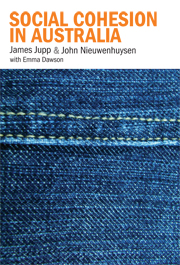Book contents
- Frontmatter
- Contents
- Foreword
- List of contributors
- List of tables
- Acknowledgments
- Introduction
- PART I DEFINING, MEASURING AND SEEKING SOCIAL COHESION
- PART II THE DYNAMICS OF SOCIAL COHESION
- PART III INFLUENCES AND RESPONSES IN SEARCHING FOR SOCIAL COHESION
- 11 Unions, the workplace and social cohesion
- 12 Education and social cohesion
- 13 The media and social cohesion
- 14 The problem of sport and social cohesion
- 15 Counter-terrorism and the politics of social cohesion
- 16 Social cohesion and human rights: would a bill of rights enhance social cohesion in Australia
- References
- Index
14 - The problem of sport and social cohesion
Published online by Cambridge University Press: 22 September 2009
- Frontmatter
- Contents
- Foreword
- List of contributors
- List of tables
- Acknowledgments
- Introduction
- PART I DEFINING, MEASURING AND SEEKING SOCIAL COHESION
- PART II THE DYNAMICS OF SOCIAL COHESION
- PART III INFLUENCES AND RESPONSES IN SEARCHING FOR SOCIAL COHESION
- 11 Unions, the workplace and social cohesion
- 12 Education and social cohesion
- 13 The media and social cohesion
- 14 The problem of sport and social cohesion
- 15 Counter-terrorism and the politics of social cohesion
- 16 Social cohesion and human rights: would a bill of rights enhance social cohesion in Australia
- References
- Index
Summary
Sport to many Australians is life and the rest a shadow.
(Horne 1964: 40)This quotation has been reproduced so often by commentators and journalists over the past four decades that its original meaning has been lost. Many of those using it have never read Donald Horne's (1964) The Lucky Country. They are using Horne's formidable reputation as a public intellectual to support the idea that Australia is a sporting nation, but miss the irony of the book's title, as well as the fact that Horne was expressing his distaste for this situation. They should read the relevant paragraphs to their conclusion, the part where competitive sport is declared to be ‘a ruthless, quasi-military operation’.
A lack of critical perspective infuses much popular writing about sport. A close reading of Horne and other sources would reveal the truth of the matter. Sport is a social activity that divides as much as it unites; it is a site for the expression of nationalist triumphalism and has contributed to the marginalisation of many groups within Australian society. Populists regard it as inappropriate to point out that, historically, many sports have a poor to moderate record of appealing to people from Culturally and Linguistically Diverse (CLD) backgrounds, have actively discriminated against Indigenous competitors, and have systematically excluded many women (Booth & Tatz 2000; Hutchins 2005). These facts are lost amid the recollection and celebration of past athletic feats, both famous and infamous.
- Type
- Chapter
- Information
- Social Cohesion in Australia , pp. 170 - 181Publisher: Cambridge University PressPrint publication year: 2007
- 5
- Cited by



